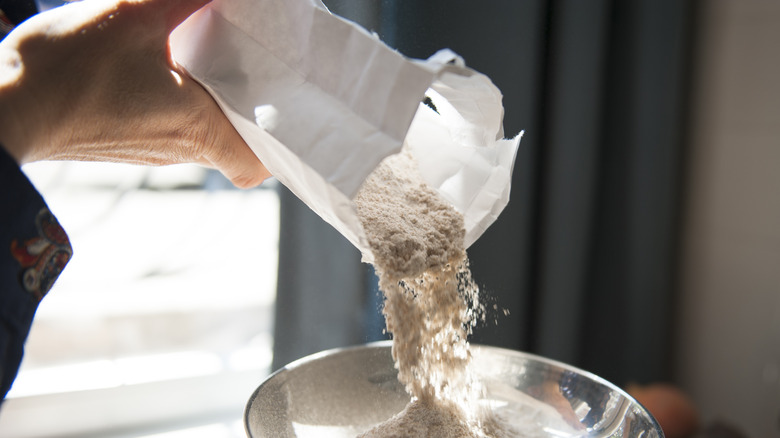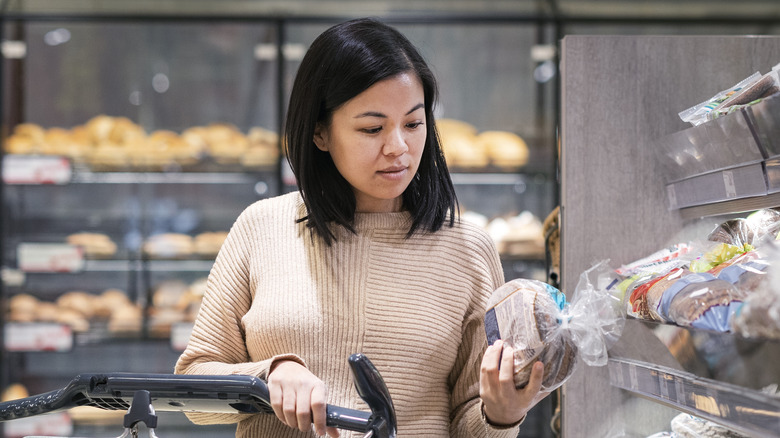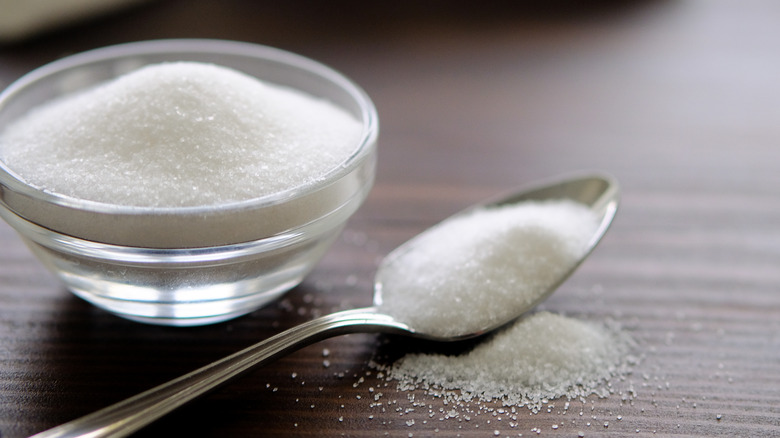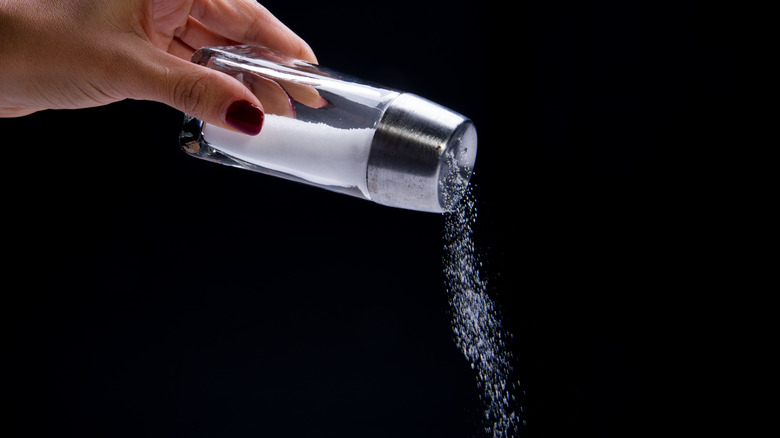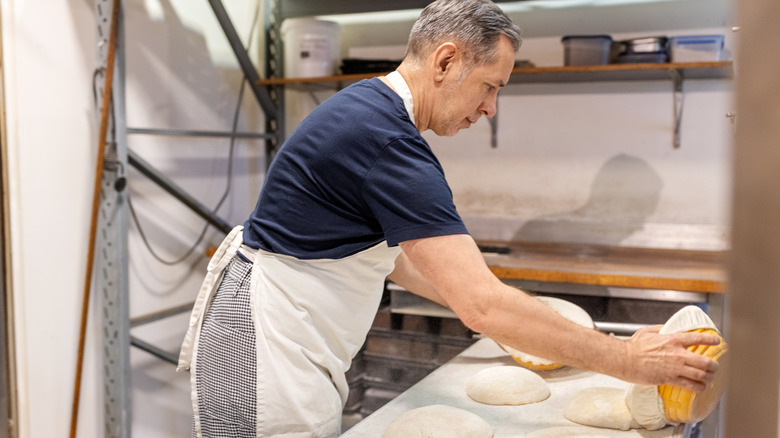What's Hiding Inside The Unhealthiest Store-Bought Sliced Bread
We may receive a commission on purchases made from links.
Sometimes, all you want is a protein-filled peanut butter sandwich. Or a slice of toast topped with fresh avocado. But one look at the bread aisle can have you wondering, "Are any of these products a decently healthy choice?"
Fortunately, yes. However, it can be challenging to figure out which bread deserves your loyalty. One way to make your decision easier is to take a gander at the list of ingredients, which should always be available (thank you, U.S. Food & Drug Administration requirements!)
Every ingredient that goes into a package of bread matters and can tell you all you need to know. However, you may be unsure of which ingredients are healthy and which aren't. That's why Health Digest contacted Lena Bakovic, a Registered Dietitian Nutritionist at Top Nutrition Coaching. Bakovic agreed to spill the beans on which unhealthy ingredients may be hiding in all those good-looking loaves.
A nutrient-deficient flour
Repeat this mantra: "I will look for breads that contain a signficant amount of whole-grain flour." Why whole grains? They haven't been processed or refined. They're complete, making them a must-have when selecting bread.
Says Bakovic, "Whole grain should ideally be listed as one of the first ingredients, followed by yeast, salt, and water (not necessarily in that order)." If you're not sure why, she explains that "the whole grain content of certain breads is beneficial due to the associated fiber load, and the many health properties of fiber, some of which include benefits to gut and cardiovascular health."
Now, it's very easy to be fooled by bread labels that claim to be "wheat," but the ingredients won't lie. When you see words like "enriched flour," you know that many whole-grain nutrients, like fiber, have been removed.
For instance, compare the U.S. Department of Agriculture (USDA) data on 100 grams of enriched wheat flour versus 100 grams of whole-grain wheat flour. The USDA shows that the enriched flour contains 2.7 grams of fiber. Yet the USDA shows that whole-grain wheat flour has 13.1 grams of fiber. That's a big difference.
Which keywords should you seek out to ensure you're getting bread made from whole-grain flour? Look for terms like "100% whole grain" or "100% whole wheat." And don't just believe the advertising verbiage on the front of the package without giving all those ingredients a once over!
A label of undecipherable words
Another red flag on a bread label is a list of ingredients that simply aren't pronounceable. Generally speaking, Bakovic recommends buying breads with limited — and familiar — ingredients.
"Some examples of ingredients to watch out for in store-bought bread include artificial dyes and flavors, preservatives such as calcium propionate, sodium benzoate, butylated hydroxyanisole (BHA), and butylated hydroxytoluene (BHT) to name just a few," notes Bakovic. Basically, if you don't know what an ingredient is, it's probably not going to contribute anything healthy to the bread. And it might even have the potential to be risky to your health.
Consider BHA, a preservative found in plenty of food products aside from bread. As noted in the 15th Report on Carcinogens from the National Toxicology Program, BHA is "reasonably anticipated to be a human carcinogen based on sufficient evidence of carcinogenicity from studies in experimental animals." BHT, which is frequently partnered with BHA in lists of preservatives, may cause dermatological responses and respiratory troubles, explains an article produced by PubChem (via National Library of Medicine).
Sodium benzoate might not be a carcinogen, but that doesn't mean it's something you want to eat. After all, it can be irritating to people who have a hypersensitivity to it, according to WebMD. (Who wants to get a skin rash or itchy skin just from eating bread?) Therefore, you may want to follow Bakovic's lead and make sure your bread is clear of any hard-to-pronounce, chemical-sounding ingredients.
No fiber but a lot of sweeteners
A good rule of thumb is to look for breads with at least 3-5 grams of fiber in each slice, according to Healthline reporting. But it can be surprisingly hard to find bread with much fiber in it. Even worse, when fiber is removed, sweeteners are often added. "Store-bought breads with low dietary fiber content are more likely to contain added sugars and be high in sodium content," agrees Bakovic.
Quite honestly, you can find a lot of breads that contain added sugars or high-fructose corn syrup. As a result, each slice could end up being as sugary as a dessert. Accordingly, an article from MedicalNewsToday cautions against eating bread that contains more than three grams of sugar in a slice.
What about artificial sweeteners or sugar alcohols? Sure, they might not add any sugar or fat to your bread but they can be rough on your gut health — and worse on your body and system. For example, an article from Johns Hopkins Medicine notes that sugar alcohols like sorbitol, erythritol, and xylitol have been known to cause stomach distress in some individuals. More disturbingly, the American Cancer Society indicates that consuming aspartame, another common artificial sweetener, could increase an individual's risk of developing certain cancers. Therefore, be on the lookout for any added sweeteners in your bread and try to buy loaves that are fiber-rich rather than lacking fiber.
Too much salt in every slice
Many bread recipes include salt, so you shouldn't be alarmed when you see it as you're examining ingredient labels. Nonetheless, be sure to scan the sodium content to be sure that too much salt hasn't been included in the bread.
Although a little bit of sodium tends to be fine for your body, too much can wreak havoc on your cardiovascular system. Consequently, authorities like the Mayo Clinic advise eating no more than 2,300 milligrams of sodium daily. Given that a slice of bread can contain 150 milligrams or more of sodium, one sandwich could deliver 300 milligrams of sodium before you put anything in the middle!
Ideally, you want your bread to contain as little sodium as possible. Consumer Reports suggests that anything under 150 milligrams of sodium per slice is acceptable. However, you could search for low-sodium breads. They exist, but you might not find them at the place you normally shop. In that case, you could always order them online and have them delivered to you (for example, Low Carb Avenue Artisan Keto Bread has only 70 milligrams of sodium in each slice). Just be sure that you read the ingredients before making your purchase through a website, just as you would in a physical store.
Plumpers for the dough
Have you ever heard of a dough conditioner? It's a product that helps the dough achieve a better rise or texture.
Dough conditioners are the final warning ingredient that Bakovic suggests avoiding. She cites bromide, diacetyl tartaric acid esters of monoglycerides (DATEM), lecithin, and azodicarbonamide (ADA) as dough conditioners that "all have the potential to carry negative implications."
She's not wrong. Some studies support her concerns. Potassium bromate, a substance that's banned in Europe, is transformed into bromide in our tissues. According to a 2021 study in Science Progress, the International Agency for Research on Cancer has classified potassium bromate as a carcinogen due to rodent studies linking it to kidney and thyroid cancer.
DATEM is currently considered to be safe for consumption. However, an older 2002 rat study showed that DATEM caused "heart muscle fibrosis and adrenal overgrowth" (via IPCS Inchem).
Healthline writes that it's controversial whether lecithin is harmful, however, some have expressed concerns about genetically modified soy being used to make soy lecithin. There are also concerns due to the fact that it's extracted using chemical solvents like hexane, which may be problematic for some.
ADA doesn't have a great reputation, either. In a 2020 study published in Central Nervous System Agents in Medicinal Chemistry, rats that were fed foods that contained ADA exhibited altered neurobehaviors.
What can you do if you're feeling flummoxed about picking the right bread? Ship a bread-baking cookbook like Peter Reinhardt's "The Bread Baker's Apprentice" to your door and try your hand at making homemade loaves. (No time to knead? No problem. A programmable breadmaker like the KBS Pro Stainless Steel Bread Machine is a great assistant.) That way, you'll always know that your bread is perfectly suited for your fit lifestyle.

